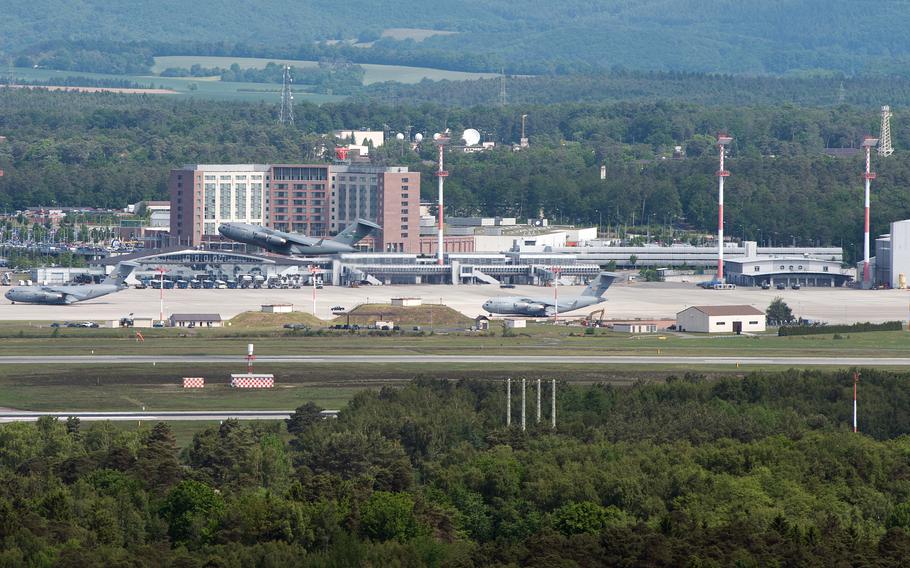
A U.S. Air Force C-17 takes off from Ramstein Air Base, Germany, in May 2019. Bases within striking distance by Russia or China must harden their defenses and be able to disperse their assets to continue operating while under attack, according to a Rand Corp. study. (Wikimedia Commons)
STUTTGART, Germany — Distance may not equal better protection when it comes to countering a potential Russian or Chinese bombardment of overseas Air Force bases, according to a new study.
The Rand Corp., in an analysis sponsored by the U.S. Air Force, said that enhancing defenses in Europe and the Pacific is imperative given recent advances by adversaries in hypersonic weaponry.
“The general impression over the past few decades that U.S. air bases were somehow sanctuaries was a historical anomaly,” the Rand report said. “With the return to a more historical norm of air base vulnerability, investments to improve air base survivability must now be made.”
Whether it’s an installation built for the long term — such as Ramstein Air Base in Germany — or a temporary site in a remote location, any base within striking distance of Russia and China must be prepared to operate while under attack. That means taking additional protective steps, such as hardening those sites and making aircraft harder to target, Rand said.
In the Pacific and Europe, U.S. Army air and missile defense systems like the Patriot and Terminal High Altitude Area Defense systems have traditionally defended bases from cruise and ballistic missile attacks.
“However, the increasingly capable adversary missiles — some of which are ballistic missiles armed with hypersonic glide vehicles — now challenge the legacy U.S. defenses,” Rand said.
Keeping a base able to operate during a battle will require “distributed operations,” including dispersal of parked aircraft, fuel systems and munitions, the report said.
For that reason, larger air bases could be more resilient than smaller ones since they allow wider dispersal. But given the range and speed of hypersonic weapons, basing at greater distances from an adversary’s border offers a false sense of security.
“Counterintuitively, distant operating locations may not be more survivable than those closer to the threat if the farther bases can be brought down by a small number of missiles,” the report said.
In recent years, the Air Force has emphasized a concept known as Agile Combat Employment, which aims to shift some operations from large, fixed airfields to more and smaller locations. In theory, adversaries would have more difficulty targeting U.S. planes.
But there are limitations to the ACE concept, Rand said. Communication systems available for ACE are “extremely limited” because of logistical and resource constraints, Rand said.
Also, Chinese and Russian capabilities to “degrade, deny, and target an opponent’s use of the electromagnetic spectrum” complicates matters.
Any solution will require a mix of options, the report said.
“ACE should be one — but not the sole — U.S. Air Force investment in enhanced air base resilience,” Rand said.
The report also noted that the Air Force in the Pacific faces bigger challenges than in Europe.
Among the advantages in Europe: more high-quality airfields available across the Continent, all accessible by road and rail, Rand said.
“In addition, NATO fighter bases generally have hardened shelters for fighter aircraft, and many of those bases have other hardened facilities,” Rand said.
The primary problem in Europe is protecting larger aircraft such as tankers, bombers and those with an intelligence role. They would need to operate from more remote bases to avoid advanced Russian aerial threats, Rand said.